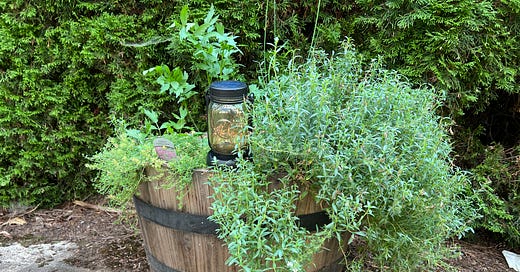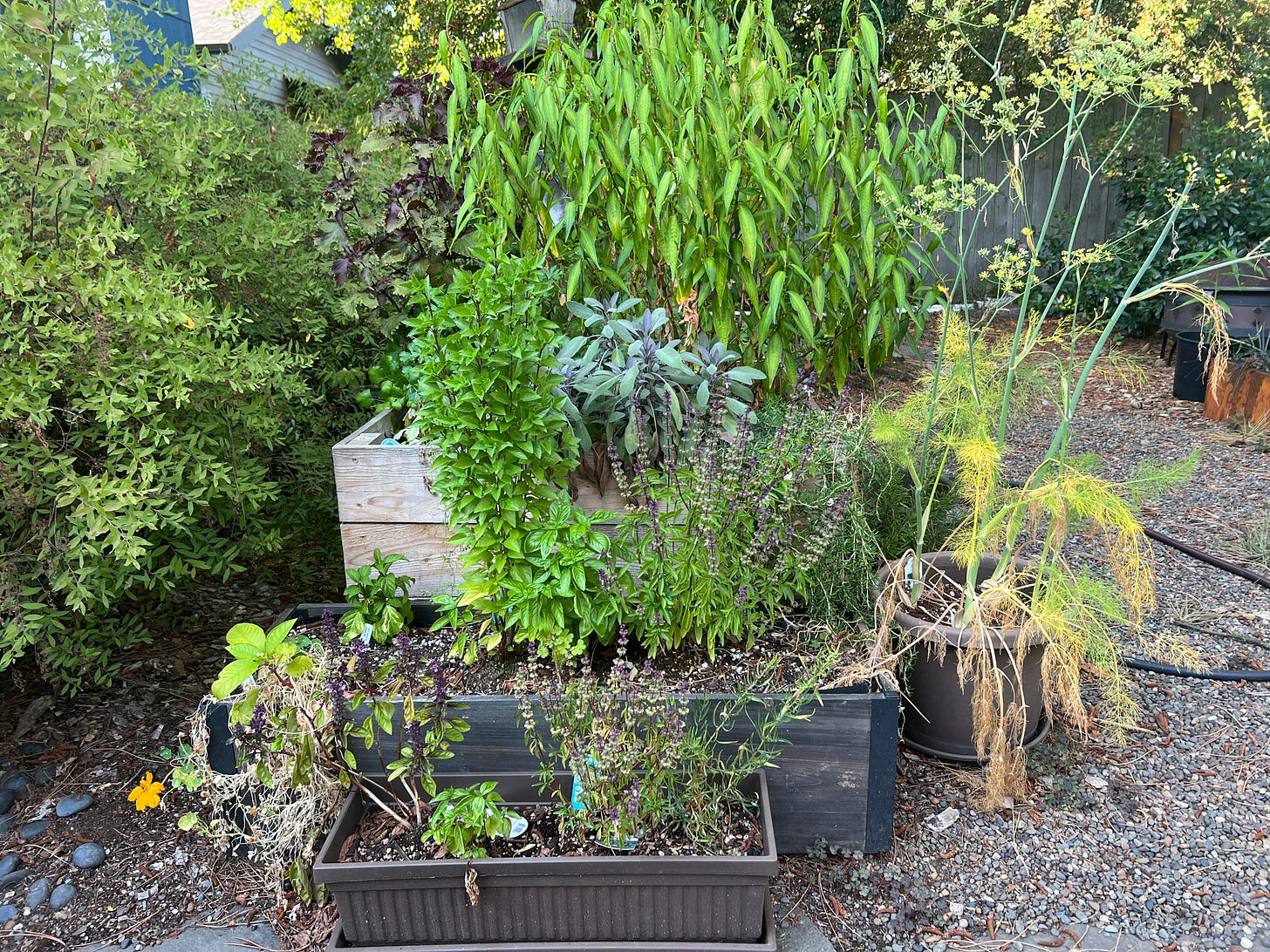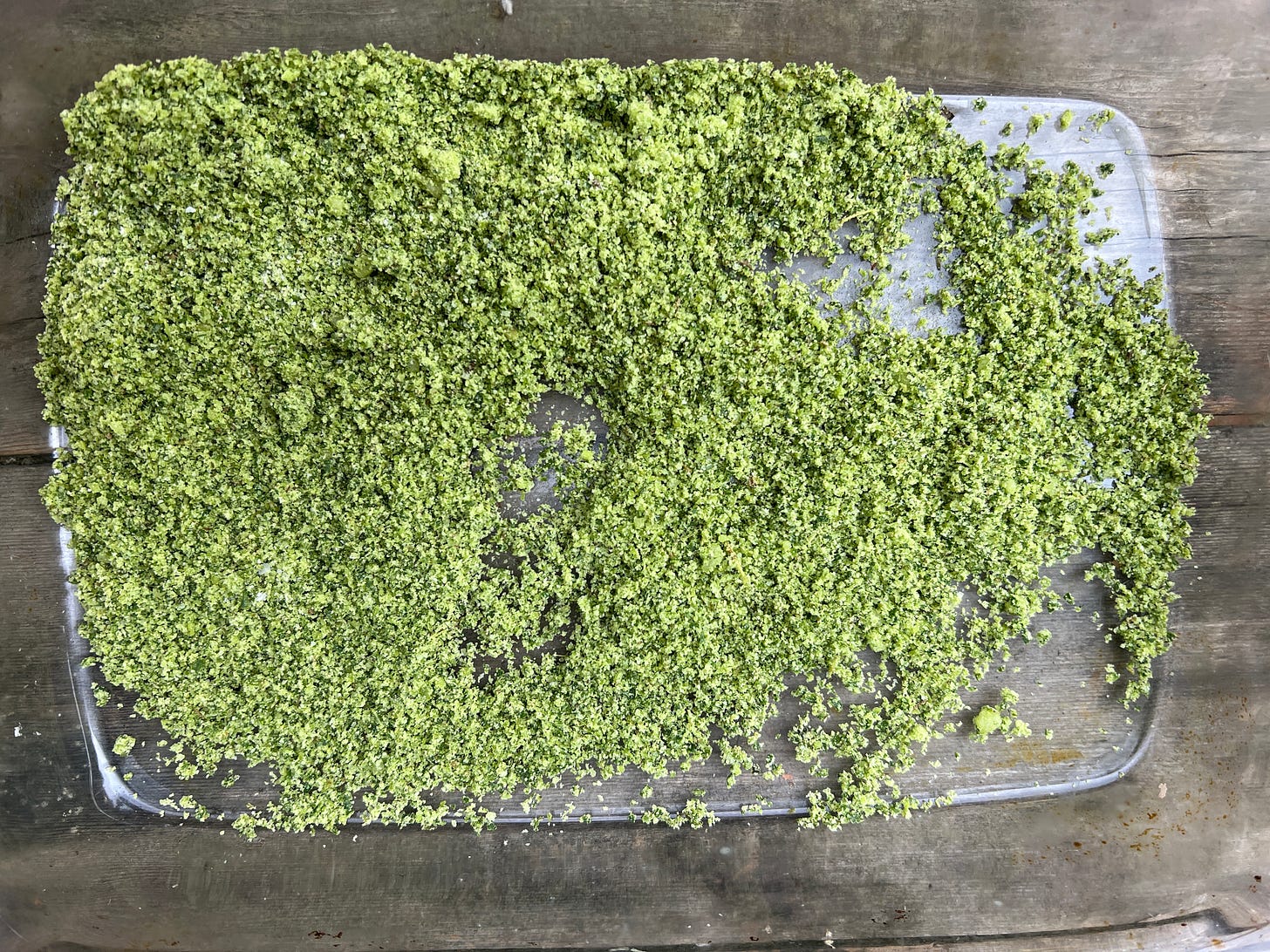On our first trip to Portland Nursery after we moved into our house in 2019, we returned home with big pots, bags of soil, and a tray of herb starts. Back in San Francisco we had planted herbs in our community garden bed, but it was located a half-mile from our apartment, and I always dreamed of stepping outside while making dinner in order to snip off a few sprigs of whatever I needed.
Christian insisted on planting a herb garden right away, perhaps to help me see beyond the shell-shock of moving and envision the possibilities of owning our own home. That first year, we grew parsley, Genovese basil, Persian mint, Thai basil, rau ram (Vietnamese coriander), and savory, my all-purpose herb. That early cluster of pots has now grown into into two big boxes, a few barrels on the driveway, and, as of this spring, the front lawn, where the plum tree is now ringed with perennial herbs. Every May and June, we spend far more than we should on herb starts to replenish the annuals that died over the winter.
We have a stupid amount of basils and mints right now. I hate sage, and yet we grow three kinds. Our rau ram is big enough to anchor an entire biome. Most of the front-lawn perennials are still deciding whether they want to spread or die away, but I hope that someday I'll walk along the path and rub my hands against the herbs I pass, scenting the air and my fingers.
My loyal savory plant now takes up most of a barrel, spilling over the sides, photogenically poofy. Back when I was cooking in restaurants, the produce folks would deliver bunches of summer savory — with its feathery leaves and soft, citrus-meets-oregano flavor — or its cousin, winter savory, whose tiny and resinous leaves tasted more akin to thyme and rosemary. I loved adding both to braised meats and pots of beans, and often showered summer savory over sautéed vegetables.
In Portland, savory has become my mascot herb, the one I usually choose over thyme, rosemary, or bay leaves. It always adds new dimension to a dish without overpowering it. With fall approaching, my own plant is undergoing its biannual metamorphosis. While you can buy "summer" and "winter" savories from nurseries, my savory, it turns out, is both: Every fall, the leaves shrink and stiffen, and the flavor intensifies. In June, new growth erupts out of the plant, and my delicate summer savory returns.
I have so much savory right now, shifting between its summer and winter guises, that I wanted to capture this transitional state. But I had no desire to make a big jar of dried herbs that I would never use. As the algorithms like to do, Instagram Reels delivered up one solution, in the form of videos (like this one) about making herb salts from an overabundant garden. It was a simple enough process: pick herbs, process them together with salt, then dry.
I've thrown away enough bottles of faded, unused herb salts that I didn't immediately feel called to reinvent Lawry's. But the flexibility of the method got me thinking about whether it would be possible to use salt to preserve a broader sense of my garden — allowing me to taste it as a landscape, not just a collection of ingredients. And that got me thinking about field blends.
I've never caught the spark of imagination that the word terroir seems to illuminate winegrowers and vintners — the way a given field's soil and climate expresses itself in the flavor of a wine, as if flavor could sketch out the profile of the land's soul. Terroir gets thrown around so much in food circles, frankly, that each time I hear the word I steel myself for the upsell.
Terroir may not intrigue me, but the idea of creating a field blend does. Briefly, with this traditional approach to growing wine grapes, you plant a smattering of different varieties that you'll harvest together at once. Some grapes ripen faster. Some contribute zippiness or inky fruit. If you've timed the picking right, the complexity and character you're seeking will all be there. You're essentially letting the land play a heavier hand in making the wine.
In places like Alsace or the region around Vienna, field blends were long the norm. Some of the oldest surviving vineyards in California are planted with field blends. This past weekend, I visited Beckham Wines in the Willamette Valley, where they’ve enjoyed the results of their field-blended white that they’re expanding the acreage.
So I decided to make a garden-blend salt, heading out to the yard with my shears and a large colander. Winter-summer savory filled up the bulk of the bowl, but to it I added tufts of coconut thyme, some feral oregano growing along the fence, some English thyme from the front lawn, and only a sprig each of rosemary and lovage, my two most pungent herbs.
It took Christian and I several hours to strip the leaves from the stems, my least favorite prep task. (Delicate, repetitive tasks? Torture.) The effort yielded 5 cups of tiny leaves. I tossed them into a food processor with a few cloves of our own garlic, then added kosher salt at at 2:1 ratio by volume.
In 60 seconds, it was all whizzed together, a sticky jade-green powder. I dried the salt in the sun for a few days, dulling the green but taming the more resinous aromas, and passed it through a sieve to remove any spiky stems. Then I stirred in a cup of finely ground Vietnamese mushroom seasoning, an MSG substitute, to ground the herbaceousness and give it depth.
I'll see how much of the blend I'll use — I'm guessing it would be good for roasted vegetables, beans, and if the vegetarian is out of town, a roast chicken. I'm curious whether, once the memory of picking the herbs fades, I'll still pick out their individual scents from the blend. To anyone who receives a jar, the salt may not smell like Jonathan and Christian's back yard in August 2023. Perhaps it will gain its own specificity, unique to a dish they make and make again. Something that reminds them vaguely of us. Something I'll never be able to recreate.










I never thought of doing that! I too dry my herbs and they sit in the cupboard untouched until I can buy new herb starts for the garden. I wonder what I can do with my herbs as the weather begins to turn. Thanks for the inspiration!
I love everything about this edition. 🙏🏽